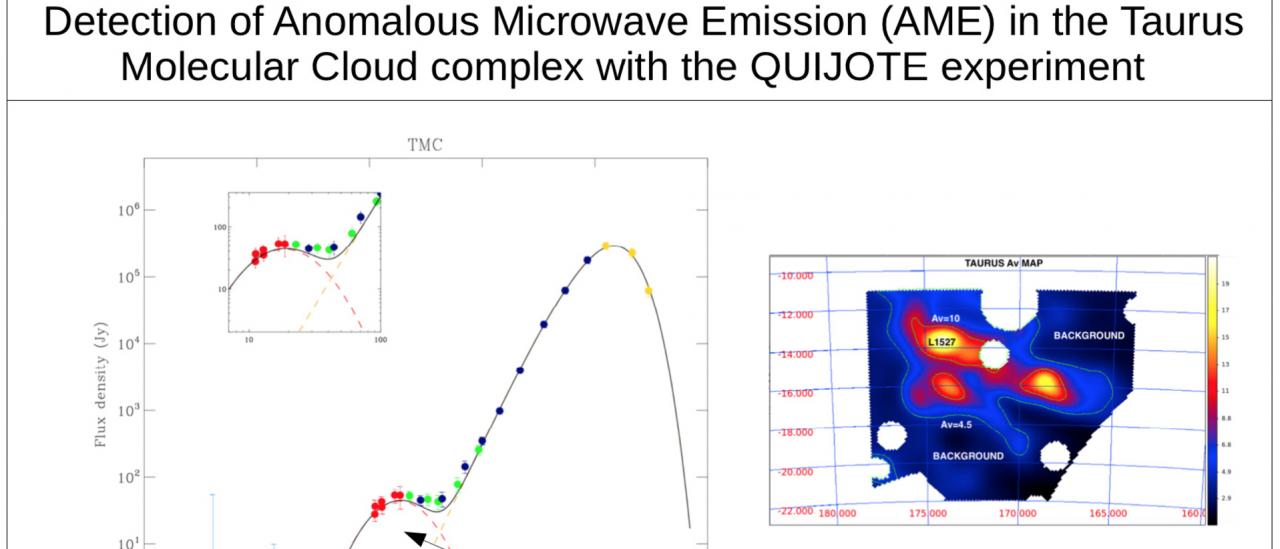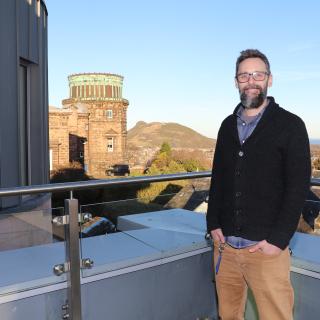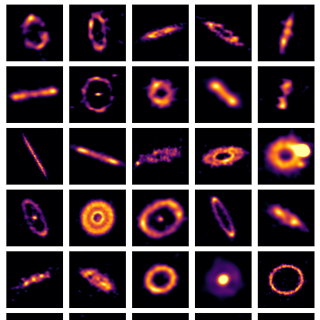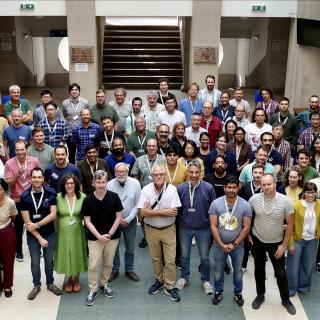The QUIJOTE experiment has two main objectives. One of them is to study the polarization of the cosmic microwave background radiation, and the other is to detect and characterize the emission produced by our own Galaxy in the same frequency range. The aim is to make a valid detection of the emission coming from the first instants of the universe.
Within the second type of studies they have detected anomalous emission of diffuse microwaves coming from the Taurus molecular cloud. Astronomers think that this type of emissions, which was first detected 20 years ago without expectations, and so the name anomalous, is produced by very fine dust particles which form a part of the interstellar medium. The polarization properties of these emissions must be characterized and understood for anyone wanting to separate out the Galactic backgrounds in order to analyse the polarization of the cosmic microwave background for cosmological results.
The molecular cloud in the constellation of Taurus (the Bull) is one of the nearest and youngest regions of star formation, where the “Anomalous Diffuse Microwave Emission” can be produced. A group of astrophysicists, led by IAC researcher Frédéric Poidevin, has used the QUIJOTE telescope, at the Teide Observatory (Tenerife) to make observations of this region, and to prove the existence of these emission processes. The observations are important because when combined with other types of observations, they permit an accurate measurement of the total emission from spinning interstellar dust.
The data obtained from the Taurus molecular cloud are part of the project PolAME, whose main aim is to characterize the degree of polarization (the geometrical orientation of the waves in the radiation) of the anomalous microwave emission from observed Galactic sources. This project is important for the Galactic research community as well as for the cosmologists. To gain its objective the PoIAME project uses new data from the QUIJOTE experiment.
The QUIJOTE project
QUIJOTE, led by the IAC, is a project which studies the cosmic microwave background radiation and its polarization, but it needs to understand the emission of microwaves in our Galaxy before it can reveal the conditions in the primordial universe.
The PoIAME project uses QUIJOTE_MFI, the main instrument of this experiment, to measure the degree of polarization of the Anomalous Microwave Emission from a series of regions containing molecular clouds and compact Galactic sources. The molecular clouds are the densest regions of the diffuse interstellar medium where the major fraction of star formation occurs in our Galaxy. They cover an important portion of the whole sky, which makes it important to understand the properties of the Anomalous Microwave Emission in these regions and not only in the diffuse interstellar medium of the Milky Way. The main aim of PoIAME is to combine data from QUIJOTE with data form the WMAP and Planck satellites, as well as with other published data to isolated the components of the Anomalous Microwave Emission and study its properties of intensity and polarization.
In the course of the PoIAME project maps were produced of the Taurus Molecular Cloud and of its sub-region LDN1527 with QUIJOTE-MFI. The quality of these for scientific use was evaluated and afterwards the procedure to use for detecting the Anomalous Microwave Emission and to characterize its degree of polarization was tested and validated. This work, published in the journal Monthly Notices of the Royal Astronomical Society (MNRAS) was carried out in collaboration with a team from the IAC, in which there was participation by Rafael Rebolo, José Alberto Rubiño Martín and Ricardo Génova-Santos, in collaboration with researchers from other nodes of the QUIJOTE consortium. The measurements of the Anomalous Microwave Emission show the relevance and the importance of the data from QUIJOTE-MFI for the bands of the electromagnetic spectrum at radio frequencies below 20 GHz. Without the information from QUIJOTE-MFI previous studies had underestimated the intensity of this emission but with the data from QUIJOTE-MFI the sites of the peaks of emission and the widths of the characteristics of the Anomalous Microwave Emission have been defined with greater precision.
QUIJOTE-MFI gives new and unique astrophysical information in intensity and polarization which was not available previously. Previous studies using aperture photometry were generally performed on what are termed point sources, which means that they concentrated on small areas of sky. The study of the Taurus Molecular Cloud was carried out over an area of some sixteen square degrees on the sky. Such a large area makes the analysis difficult, but in spite of the difficulty it has been possible to make a clear detection of Anomalous Microwave Emission in this area. The study improves the statistics of the detection of the Anomalous Microwave Emission from Galactic sources, and confirms the low level of polarization expected form this component.
All the results obtained until now are important for subsequence cosmological studies because they show that the degree of polarization of the galactic backgrounds could be quite low, if they are polarized at all.
The QUIJOTE CMB Experiment is a scientific collaboration between the Instituto de Astrofísica de Canarias, the Instituto de Física de Cantabria, the Department of Communications Engineering (Santander), the Cavendish Laboratory (Cambridge) and the Company IDOM. It began operation in 2012 and comprises two telescopes and three instruments dedicated to measure the polarization of the sky in microwaves at frequencies in the range between 10º GHs and 42 GHz.
The Observatories of the Instituto de Astrofísica de Canarias (IAC) are part of the network of Singular Scientific and Technical Infrastructures (ICTS) of Spain.
Scientific article: Poidevin F. et al. "QUIJOTE Scientific results. III. Microwave spectrum of intensity and polarization in the Taurus molecular cloud Complex and L1527", Monthly Notices of the Royal Astronomical Society, Volume 486, Issue 1, June 2019, Pages 462–485, https://doi.org/10.1093/mnras/sty3462
ADS: http://adsabs.harvard.edu/doi/10.1093/mnras/sty3462
Links of interest:
PolAME project: http://www.iac.es/proyecto/polame/
QUIJOTE experiment: http://www.iac.es/proyecto/cmb/pages/en/home-cmb.php




